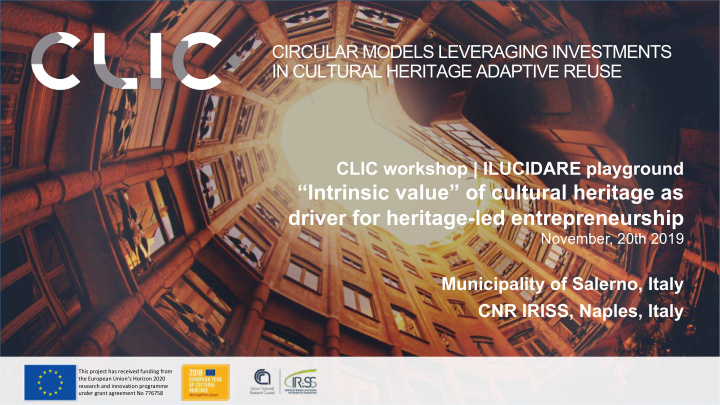



CIRCULAR MODELS LEVERAGING INVESTMENTS IN CULTURAL HERITAGE ADAPTIVE REUSE CLIC workshop | ILUCIDARE playground “Intrinsic value” of cultural heritage as driver for heritage-led entrepreneurship November, 20th 2019 Municipality of Salerno, Italy CNR IRISS, Naples, Italy This project has received funding from the European Union’s Horizon 2020 research and innovation programme under grant agreement No 776758
IRCULAR E CONOMY
ULTURAL H ERITAGE ( ADAPTIVE REUSE )
The CLIC model of functional reuse of cultural heritage
Heritage Values Non-instrumental value «INTRINSIC VALUE» Cultural heritage counts for Europe, 2015
S ALERNO , I TALY
G IARDINO DELLA M INERVA , S ALERNO
Giar Giardin ino o della lla Mi Mine nerva, , Sa Saler erno Th The plac lace of f the ancien an ient Me Medical Sc School, the most an ancien ient the therape peuti utic bo botani nic ga garden in Eur Europe pe
# Recovery of traditional water system # Nature regeneration # Jobs creation # Regeneration of knowledge # 10.000 visitors / year
Route of the The project: a Eur Europe pean n Cul ultur ural Ro hi historic th ther erap apeu eutic tic bo botani nic ga gardens • Entrepreneurship-led historical Cultural Routes • Develop the entrepreneurial ecosystem in heritage- related sectors • Enhance the «intrinsic value» of this tangible and intangible, cultural and natural heritage
Entrepreneurial ecosystems Domains Actors Policy Markets Finance Human Culture capital Supports Daniel Isenberg, Head of Babson University’s Entrepreneurship Ecosystem Project – Urbact BlueAct project in Salerno, Italy
Entrepreneurial ecosystems: ACTORS Pillar Universities & Human capital companies Research providers Investment capital Mentors providers SHARED VALUES
Po Potential heritage-led led en entr trep epren eneu eurial ial sec ectors • agri-food products (linked to the Mediterranean diet – UNESCO world heritage) • cosmetics and pharmaceutical research • arts, crafts • wellness • medical research • business tourism (e.g. linked to congresses) • health and digital health • inclusive tourism offers (e.g. providing opportunities for families, children, disabled people) • cultural activities such as theatre, festivals, performances • …
The Business Model of enterprises involved in cultural heritage regeneration, valorization and adaptive reuse
Traditional Business Model R2pi Circular Business Model ROCK heritage Business Model
The Triple Layered business model canvas to move towards sustainable business models
The CLIC Circular Business Model: towards a proposal
Key partners Key activities Customers Customer VALUE relationships segments PROPOSITION Social Complex Value of cultural heritage = (TEV, I ) • Use values (direct and indirect) Key resources Channels • Non use values (Option, Existence, Bequest) • «Intrinsic value» Revenue streams Costs Social impacts, Environmental impacts and Economic spillovers
Structure of this workshop
1. WHICH STAKEHOLDERS ARE PART OF THE ENTREPRENEURIAL ECOSYSTEM? (10 min) 2. WHICH ACTIONS CAN STAKEHOLDERS TAKE TO ENHANCE THE ENTREPRENEURIAL ECOSYSTEM? (10 min) 3. WHICH QUESTIONS ARE RELEVANT FOR HERITAGE-LED ENTREPRISES TO RUN THEIR CIRCULAR BUSINESS? (10 min)
Recommend
More recommend